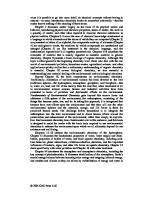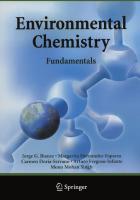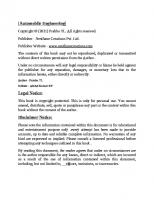Fundamentals of Environmental Engineering 9781566700474
558 37 2MB
English Pages 545 Year 1998
Table of contents :
Cover......Page 1
Title Page......Page 2
Copyright Page......Page 3
Preface......Page 4
Author......Page 6
Nomenlature......Page 8
Table of Contents......Page 12
1.1 What is Environmental Engineering?......Page 20
1.2 The Environmental Engineering Process- Modeling......Page 23
1.3 Example Activities of Environmental Engineers......Page 26
1.4.1 Early History......Page 29
1.4.2 Air Pollution Episodes......Page 30
1.4.3 Water Pollution Regulation in the U.S......Page 32
1.4.5 Los Angeles "Smog"......Page 34
Problems......Page 37
References......Page 38
2.2.1 Population Growth and Standard of Living......Page 40
2.2.1.1 Population......Page 41
2.2.1.2 Standard of Living......Page 44
2.2.2 Loss of Biological Diversity......Page 45
2.2.3 Global Warming......Page 46
2.2.4 Stratospheric Ozone Depletion......Page 50
2.3.1 Introduction......Page 54
2.3.2 Oxides of Carbon......Page 56
2.3.3 Oxides of Sulfur......Page 57
2.3.4 Oxides of Nitrogen......Page 61
2.3.5 Organic Pollutants......Page 62
2.3.6 Photochemical Oxidants......Page 63
2.3.7 Particulates......Page 64
2.4.1 Introduction......Page 67
2.4.2 Organic Materials......Page 68
2.4.3 Suspended and Floating Solids......Page 71
2.4.4.1 Pesticides......Page 72
2.4.4.2 Polychlorinated Biphenyls......Page 73
2.4.4.4 Halogenated Aliphatics......Page 74
2.4.4.7 Phenols......Page 75
2.4.4.10 Nitrosamines......Page 76
2.5.1 Approaches......Page 77
2.5.2 Environmental Assessment Criteria......Page 78
2.5.2.2 Environmental Quality Standards......Page 79
2.5.2.4 Cost-Benefit Analysis......Page 83
2.5.2.5 Community-Based Standards......Page 85
2.5.3 Assessment of Environmental Effects......Page 87
2.5.3.1 Exposure Assessment......Page 89
2.5.3.2 Human Health Risk Assessment......Page 93
2.6.1 Pollution Prevention......Page 100
2.6.1.1 Lifestyle Analysis......Page 101
2.6.1.2 Operation for Pollution Prevention......Page 102
2.6.3 Destruction, Treatment, or Storage of Wastes......Page 103
Problems......Page 104
References......Page 105
3.1 Systems of Units......Page 108
3.2.1 Density and Concentration......Page 111
3.2.2 Reaction Stoichiometry......Page 117
3.2.3 Temperature......Page 119
3.2.4 Pressure......Page 120
3.3 Dimensional Analysis......Page 124
3.4.1 Mean and Standard Deviation......Page 128
3.4.2.1 Gaussian Distribution......Page 131
3.4.2.2 Log-Normal Distribution......Page 134
3.4.3 Propagation of Error......Page 135
3.4.4 Fitting Data......Page 138
3.4.4.1 Linearization and Errors......Page 140
3.4.4.2 General Linear Regression......Page 143
Problems......Page 145
References......Page 148
4.1.1 Pure Ideal Gases......Page 150
4.1.2 Non-Ideal Gases......Page 152
4.1.3 Ideal Gas Mixtures......Page 157
4.1.4 General Phase Behavior......Page 159
4.2 Thennodynamics of Phase Changes......Page 161
4.2.1 Sensible Heat Transitions......Page 162
4.2.2 Latent Heat Transitions......Page 168
4.3 Thennodynamics of Equilibrium......Page 169
4.3.1 First and Second Laws of Thennodynamics......Page 170
4.3.2 Gibb's Free Energy and Equilibrium......Page 173
4.4 Vapor Pressure......Page 178
4.5 Solubility......Page 181
4.6 Fluid-Fluid Partitioning......Page 185
4.6.1 Ideal Solutions......Page 186
4.6.2 Nonideal Solutions......Page 188
4.6.3 Ionic Solutions......Page 193
4.7 Fluid-Solid Partitioning......Page 194
4.7.1 Linear Partitioning......Page 196
4.7.2 Langmuir Isotherm......Page 200
4.7.3 Brauner-Emmett-Teller (BET) Isothenn......Page 201
4.7.4 Freundlich lsothenn......Page 203
4.8 Equilibrium Models......Page 204
4.8.1 Fugacity Modeling......Page 209
4.9 Chemical Equilibrium......Page 211
4.10 Acid Dissociation Constant......Page 218
4.11 Mineral Dissolution Reactions......Page 222
4.12 Ion Exchange and Adsorption......Page 223
4.13 Oxidation-Reduction Reactions......Page 226
Problems......Page 228
References......Page 230
5.1 Introduction......Page 232
5.2.1 Basic Concepts......Page 235
5.2.2 Steady-State Material Balance......Page 239
5.2.3 Dynamic Balance on a Stirred System......Page 244
5.2.4 Balance on an Unstirred System......Page 248
5.3.1 Irreversible Reactions - Kinetic Models......Page 250
5.3.2 Estimation of Reaction Rate Parameters......Page 253
5.3.3 Reversible Reactions......Page 255
5.3.4 Reversible Processes and System Dynamics......Page 256
5.4.1 Advection......Page 259
5.4.2 Diffusion- Fick's First Law......Page 260
5.4.3 Film Theory of Mass Transfer......Page 264
5.4.4 Two-Fihn Theory......Page 266
5.4.5 Diffusion of Heat.......Page 272
5.4.6 Diffusion of Momentum......Page 273
5.5.1 Turbulent Fluctuations......Page 274
5.5.2 Mixing Length Theory......Page 279
5.5.3 The Logarithmic Velocity Profile Law......Page 280
5.5.4 Heat, Mass, and Momentum Transfer Analogies......Page 282
5.5.5 The Effect of Stratification on Turbulent Transport......Page 283
5.6.1 Development of Microscopic Balances......Page 286
5.6.2 Error Function Solution to the Microscopic Material Balance......Page 289
5.6.3 Solutions to the Advection-Diffusion Equation......Page 291
Problems......Page 295
References......Page 298
6.2.1 Global Atmospheric Structure and Mixing......Page 300
6.2.2 Global Circulation......Page 305
6.2.3 Regional Processes......Page 309
6.2.3.2 Eckman Spiral......Page 311
6.2.3.3 Local Winds......Page 313
6.2.4.1 Boundary Layer Temperature Structure......Page 314
6.2.4.2 Boundary Layer Velocity Profile......Page 322
6.2.4.3 Empirical Turbulence Classification Schemes......Page 323
6.3 Pollutant Transport and Dispersion in the Boundary Layer......Page 325
6.3.1 Well-Mixed Box Model for Area Sources......Page 329
6.3.2 Point Source Dispersion Model......Page 331
6.3.2.1 Plume Rise......Page 332
6.3.2.2 Point Source Dispersion......Page 335
6.3.2.3 Parameter Estimation......Page 338
6.4.1 Gravity Settling......Page 346
6.4.2 Particle Settling in the Atmosphere......Page 351
6.4.3 Gravity Settlers......Page 352
6.4.3.1 Unmixed Collector......Page 353
6.4.3.2 Plug Flow Collector......Page 354
6.4.3.3 Completely Mixed Settler......Page 355
6.4.4 Cyclone Separator......Page 356
6.4.5 Electrostatic Precipitator......Page 359
6.4.6 Wet Collectors......Page 363
6.4.7 Filter Collectors......Page 368
6.5.1 Process Changes to Control Gaseous Emissions......Page 369
6.5.2.1 Afterburners......Page 371
6.5.3 Sorption Processes - Adsorption......Page 372
6.5.4 Sorption Processes- Absorption......Page 378
Problems......Page 384
References......Page 388
7.2.1 Ocean and Lake Circulations......Page 390
7.2.2 Flow in Streams......Page 392
7.2.3 Surface Water Runoff......Page 395
7.2.4 Stratification and Stability in Temperate, Shallow Freshwater Systems......Page 397
7.2.5 Other Effects on Stability of Surface Waters......Page 399
7.3 Contaminant Processes in Surface Waters......Page 401
7.3.1 Phase Partitioning in Surface Waters......Page 402
7.3.2 Turbulent Mixing and Transport in Streams, Lakes, and Oceans......Page 405
7.3.2.1 Transport Across the Air-Water Interface......Page 406
7.3.2.2 Transport Near the Sediment-Water Interface......Page 408
7.3.2.3 Mixing in Lakes and Oceans......Page 410
7.3.3 Chemical and Biological Degradation Processes in Surface Waters......Page 412
7.3.4 Kinetics of Biological Degradation Processes......Page 415
7.4.2 Stream Model......Page 418
7.4.3 Lake Model......Page 422
7.5.1 Summary of Processes......Page 424
7.5.2 Sediment Structure......Page 425
7.5.3 Sediment Erosion......Page 428
7.5.4 Bioturbation......Page 431
7.5.6 Contaminant Transport by Porewater Processes......Page 433
7.6.1 Fundamentals of Sedimentation......Page 437
7.6.2 Flocculation......Page 440
7.6.3 Hindered Settling......Page 441
7.7 Secondary Wastewater Treatment......Page 443
7.7.1 Aerated Lagoon......Page 444
7.7.2 Activated Sludge System......Page 445
7.8.3 Filtration......Page 450
7.8.4 Ion Exchange......Page 453
7.8.5 Membrane Processes......Page 454
Problems......Page 458
References......Page 461
8.2 Soil Characteristics......Page 462
8.2.1 Solid Phase Characteristics......Page 463
8.2.2 Flow of Fluid in Fully Saturated Media......Page 466
8.2.3 Flow of Fluid in a Partially Saturated Media......Page 476
8.3 Contaminant Transport in Soils......Page 481
8.3.1 First Zone of Con Lamination - NAPL Residual in the Vadose Zone......Page 483
8.3.2 Second Zone of Contamination -Contaminant Vapors in Vadose Zone......Page 487
8.3.3 Third Zone of Contamination- NAPL Residual in Initially Water-Saturated Zone......Page 490
8.3.4 Fourth Zone of Contamination - Dissolved Contaminant in Subsurface Water......Page 492
8.3.5 Natural Attenuation of Contaminants in Soils......Page 499
8.5.1 Incineration......Page 501
8.5.2 Landfilling......Page 502
8.5.3 Stabilization/Solidification......Page 503
8.6 In Situ Soil Remediation Processes......Page 504
8.6.1 Pump and Treat Extraction of Contaminated Ground water......Page 505
8.6.3 Vacuum Extraction in the Unsaturated Zone......Page 508
8.6.4 In Situ Bioremediation of Soils......Page 512
Problems......Page 513
References......Page 516
Appendix......Page 518
Index......Page 526
Cover......Page 1
Title Page......Page 2
Copyright Page......Page 3
Preface......Page 4
Author......Page 6
Nomenlature......Page 8
Table of Contents......Page 12
1.1 What is Environmental Engineering?......Page 20
1.2 The Environmental Engineering Process- Modeling......Page 23
1.3 Example Activities of Environmental Engineers......Page 26
1.4.1 Early History......Page 29
1.4.2 Air Pollution Episodes......Page 30
1.4.3 Water Pollution Regulation in the U.S......Page 32
1.4.5 Los Angeles "Smog"......Page 34
Problems......Page 37
References......Page 38
2.2.1 Population Growth and Standard of Living......Page 40
2.2.1.1 Population......Page 41
2.2.1.2 Standard of Living......Page 44
2.2.2 Loss of Biological Diversity......Page 45
2.2.3 Global Warming......Page 46
2.2.4 Stratospheric Ozone Depletion......Page 50
2.3.1 Introduction......Page 54
2.3.2 Oxides of Carbon......Page 56
2.3.3 Oxides of Sulfur......Page 57
2.3.4 Oxides of Nitrogen......Page 61
2.3.5 Organic Pollutants......Page 62
2.3.6 Photochemical Oxidants......Page 63
2.3.7 Particulates......Page 64
2.4.1 Introduction......Page 67
2.4.2 Organic Materials......Page 68
2.4.3 Suspended and Floating Solids......Page 71
2.4.4.1 Pesticides......Page 72
2.4.4.2 Polychlorinated Biphenyls......Page 73
2.4.4.4 Halogenated Aliphatics......Page 74
2.4.4.7 Phenols......Page 75
2.4.4.10 Nitrosamines......Page 76
2.5.1 Approaches......Page 77
2.5.2 Environmental Assessment Criteria......Page 78
2.5.2.2 Environmental Quality Standards......Page 79
2.5.2.4 Cost-Benefit Analysis......Page 83
2.5.2.5 Community-Based Standards......Page 85
2.5.3 Assessment of Environmental Effects......Page 87
2.5.3.1 Exposure Assessment......Page 89
2.5.3.2 Human Health Risk Assessment......Page 93
2.6.1 Pollution Prevention......Page 100
2.6.1.1 Lifestyle Analysis......Page 101
2.6.1.2 Operation for Pollution Prevention......Page 102
2.6.3 Destruction, Treatment, or Storage of Wastes......Page 103
Problems......Page 104
References......Page 105
3.1 Systems of Units......Page 108
3.2.1 Density and Concentration......Page 111
3.2.2 Reaction Stoichiometry......Page 117
3.2.3 Temperature......Page 119
3.2.4 Pressure......Page 120
3.3 Dimensional Analysis......Page 124
3.4.1 Mean and Standard Deviation......Page 128
3.4.2.1 Gaussian Distribution......Page 131
3.4.2.2 Log-Normal Distribution......Page 134
3.4.3 Propagation of Error......Page 135
3.4.4 Fitting Data......Page 138
3.4.4.1 Linearization and Errors......Page 140
3.4.4.2 General Linear Regression......Page 143
Problems......Page 145
References......Page 148
4.1.1 Pure Ideal Gases......Page 150
4.1.2 Non-Ideal Gases......Page 152
4.1.3 Ideal Gas Mixtures......Page 157
4.1.4 General Phase Behavior......Page 159
4.2 Thennodynamics of Phase Changes......Page 161
4.2.1 Sensible Heat Transitions......Page 162
4.2.2 Latent Heat Transitions......Page 168
4.3 Thennodynamics of Equilibrium......Page 169
4.3.1 First and Second Laws of Thennodynamics......Page 170
4.3.2 Gibb's Free Energy and Equilibrium......Page 173
4.4 Vapor Pressure......Page 178
4.5 Solubility......Page 181
4.6 Fluid-Fluid Partitioning......Page 185
4.6.1 Ideal Solutions......Page 186
4.6.2 Nonideal Solutions......Page 188
4.6.3 Ionic Solutions......Page 193
4.7 Fluid-Solid Partitioning......Page 194
4.7.1 Linear Partitioning......Page 196
4.7.2 Langmuir Isotherm......Page 200
4.7.3 Brauner-Emmett-Teller (BET) Isothenn......Page 201
4.7.4 Freundlich lsothenn......Page 203
4.8 Equilibrium Models......Page 204
4.8.1 Fugacity Modeling......Page 209
4.9 Chemical Equilibrium......Page 211
4.10 Acid Dissociation Constant......Page 218
4.11 Mineral Dissolution Reactions......Page 222
4.12 Ion Exchange and Adsorption......Page 223
4.13 Oxidation-Reduction Reactions......Page 226
Problems......Page 228
References......Page 230
5.1 Introduction......Page 232
5.2.1 Basic Concepts......Page 235
5.2.2 Steady-State Material Balance......Page 239
5.2.3 Dynamic Balance on a Stirred System......Page 244
5.2.4 Balance on an Unstirred System......Page 248
5.3.1 Irreversible Reactions - Kinetic Models......Page 250
5.3.2 Estimation of Reaction Rate Parameters......Page 253
5.3.3 Reversible Reactions......Page 255
5.3.4 Reversible Processes and System Dynamics......Page 256
5.4.1 Advection......Page 259
5.4.2 Diffusion- Fick's First Law......Page 260
5.4.3 Film Theory of Mass Transfer......Page 264
5.4.4 Two-Fihn Theory......Page 266
5.4.5 Diffusion of Heat.......Page 272
5.4.6 Diffusion of Momentum......Page 273
5.5.1 Turbulent Fluctuations......Page 274
5.5.2 Mixing Length Theory......Page 279
5.5.3 The Logarithmic Velocity Profile Law......Page 280
5.5.4 Heat, Mass, and Momentum Transfer Analogies......Page 282
5.5.5 The Effect of Stratification on Turbulent Transport......Page 283
5.6.1 Development of Microscopic Balances......Page 286
5.6.2 Error Function Solution to the Microscopic Material Balance......Page 289
5.6.3 Solutions to the Advection-Diffusion Equation......Page 291
Problems......Page 295
References......Page 298
6.2.1 Global Atmospheric Structure and Mixing......Page 300
6.2.2 Global Circulation......Page 305
6.2.3 Regional Processes......Page 309
6.2.3.2 Eckman Spiral......Page 311
6.2.3.3 Local Winds......Page 313
6.2.4.1 Boundary Layer Temperature Structure......Page 314
6.2.4.2 Boundary Layer Velocity Profile......Page 322
6.2.4.3 Empirical Turbulence Classification Schemes......Page 323
6.3 Pollutant Transport and Dispersion in the Boundary Layer......Page 325
6.3.1 Well-Mixed Box Model for Area Sources......Page 329
6.3.2 Point Source Dispersion Model......Page 331
6.3.2.1 Plume Rise......Page 332
6.3.2.2 Point Source Dispersion......Page 335
6.3.2.3 Parameter Estimation......Page 338
6.4.1 Gravity Settling......Page 346
6.4.2 Particle Settling in the Atmosphere......Page 351
6.4.3 Gravity Settlers......Page 352
6.4.3.1 Unmixed Collector......Page 353
6.4.3.2 Plug Flow Collector......Page 354
6.4.3.3 Completely Mixed Settler......Page 355
6.4.4 Cyclone Separator......Page 356
6.4.5 Electrostatic Precipitator......Page 359
6.4.6 Wet Collectors......Page 363
6.4.7 Filter Collectors......Page 368
6.5.1 Process Changes to Control Gaseous Emissions......Page 369
6.5.2.1 Afterburners......Page 371
6.5.3 Sorption Processes - Adsorption......Page 372
6.5.4 Sorption Processes- Absorption......Page 378
Problems......Page 384
References......Page 388
7.2.1 Ocean and Lake Circulations......Page 390
7.2.2 Flow in Streams......Page 392
7.2.3 Surface Water Runoff......Page 395
7.2.4 Stratification and Stability in Temperate, Shallow Freshwater Systems......Page 397
7.2.5 Other Effects on Stability of Surface Waters......Page 399
7.3 Contaminant Processes in Surface Waters......Page 401
7.3.1 Phase Partitioning in Surface Waters......Page 402
7.3.2 Turbulent Mixing and Transport in Streams, Lakes, and Oceans......Page 405
7.3.2.1 Transport Across the Air-Water Interface......Page 406
7.3.2.2 Transport Near the Sediment-Water Interface......Page 408
7.3.2.3 Mixing in Lakes and Oceans......Page 410
7.3.3 Chemical and Biological Degradation Processes in Surface Waters......Page 412
7.3.4 Kinetics of Biological Degradation Processes......Page 415
7.4.2 Stream Model......Page 418
7.4.3 Lake Model......Page 422
7.5.1 Summary of Processes......Page 424
7.5.2 Sediment Structure......Page 425
7.5.3 Sediment Erosion......Page 428
7.5.4 Bioturbation......Page 431
7.5.6 Contaminant Transport by Porewater Processes......Page 433
7.6.1 Fundamentals of Sedimentation......Page 437
7.6.2 Flocculation......Page 440
7.6.3 Hindered Settling......Page 441
7.7 Secondary Wastewater Treatment......Page 443
7.7.1 Aerated Lagoon......Page 444
7.7.2 Activated Sludge System......Page 445
7.8.3 Filtration......Page 450
7.8.4 Ion Exchange......Page 453
7.8.5 Membrane Processes......Page 454
Problems......Page 458
References......Page 461
8.2 Soil Characteristics......Page 462
8.2.1 Solid Phase Characteristics......Page 463
8.2.2 Flow of Fluid in Fully Saturated Media......Page 466
8.2.3 Flow of Fluid in a Partially Saturated Media......Page 476
8.3 Contaminant Transport in Soils......Page 481
8.3.1 First Zone of Con Lamination - NAPL Residual in the Vadose Zone......Page 483
8.3.2 Second Zone of Contamination -Contaminant Vapors in Vadose Zone......Page 487
8.3.3 Third Zone of Contamination- NAPL Residual in Initially Water-Saturated Zone......Page 490
8.3.4 Fourth Zone of Contamination - Dissolved Contaminant in Subsurface Water......Page 492
8.3.5 Natural Attenuation of Contaminants in Soils......Page 499
8.5.1 Incineration......Page 501
8.5.2 Landfilling......Page 502
8.5.3 Stabilization/Solidification......Page 503
8.6 In Situ Soil Remediation Processes......Page 504
8.6.1 Pump and Treat Extraction of Contaminated Ground water......Page 505
8.6.3 Vacuum Extraction in the Unsaturated Zone......Page 508
8.6.4 In Situ Bioremediation of Soils......Page 512
Problems......Page 513
References......Page 516
Appendix......Page 518
Index......Page 526










